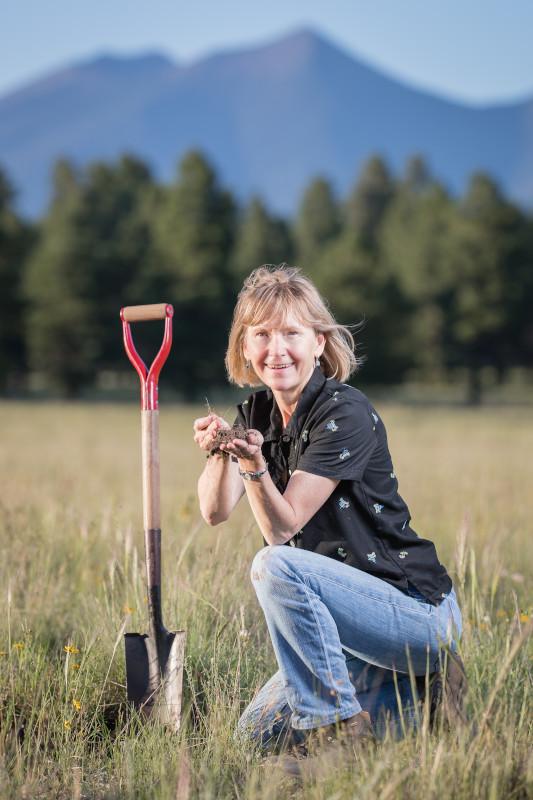Findings will help advance basic understanding of the genetic mechanisms by which plants control their associations with potentially beneficial root-associated microbes

Credit: Courtesy Northern Arizona University
For years, researchers have been trying to harness the crop-growing benefits of the symbiotic relationship between plants and fungi. Arbuscular mycorrhizal fungi (AMF), for example, can deliver water and nutrients to the roots of plants like sorghum, a grain used to produce biofuels. The US Department of Energy (DOE) is particularly interested in producing sorghum more efficiently to reduce the need for irrigation and fertilizer, and recently awarded Regents’ Professor Nancy Johnson of Northern Arizona University’s School of Earth and Sustainability a $1.3 million grant to study the beneficial associations between biofuel sorghum and AMF.
Johnson’s research is part of a five-year collaboration with the University of Georgia, funded by a total of $11.7 million from the DOE, which will involve genetic sequencing and artificial intelligence. A series of field and greenhouse experiments will examine the genetic and environmental factors that cause the variable performance of mycorrhizal symbioses in field conditions.
“Despite decades of efforts, successful use of AMF as biofertilizers has been elusive, largely because mycorrhizae are complex systems and their effects are context dependent,” Johnson said. “Environmental conditions, and especially soil fertility and water availability, influence the degree to which AMF can improve sorghum production. Also, different genetic lines of sorghum vary in mycorrhizal responsiveness, and complex communities of AMF and other soil microbes differ in their effects on the nutrient and water relations of their host plants.”
Scientists will be conducting shotgun (metagenomic) sequencing to understand what microscopic communities exist in samples of sorghum roots. “Shotgun sequencing reveals all the genetic sequences in samples,” Johnson said. “Until recently, there was too much information, but now with advanced computing and bioinformatics, you can figure out what a lot of the organisms are. We’re recognizing there’s kind of a dance between the plant roots and AMF, and to a certain extent, the plant can select which fungi it associates with to form mycorrhizal symbioses. This research will help us learn more about the process by which plants control their microbiome under different environmental conditions.”
The researchers will be growing more than 350 different genotypes of sorghum at agricultural experiment stations in Maricopa, Arizona and near Athens, Georgia to examine how sorghum genetics are interacting with AMF and other organisms in their microbiome.
“We’ll characterize which microbes are active in their roots by measuring RNA as well as the DNA. Once we see what’s going on in agricultural fields, we’ll make single-spore cultures of AMF and grow them in controlled experiments,” Johnson said. Systems models will be constructed that link sorghum performance with the communities of AMF and other microbes in the field experiments, and these models will be tested in the NAU Research Greenhouse complex.
To complement the genomic and transcriptomic work, the scientists will apply novel imaging tools to visualize the interactions between sorghum roots and AMF. Johnson will use microscopy in her Soil Ecology Lab at NAU to identify fungal allocation patterns, which will add a spatial context to the research.
“We’ll stain the AMF in the roots and examine them under a light microscope. We’ll take pictures and use artificial intelligence to teach the computer how to recognize and quantify fungal structures in thousands of root samples.” Using innovative convolutional neural network software, the computer will be able to identify AMF and also non-mycorrhizal fungi.
“The Department of Energy wants to be able to produce biofuels more sustainably by helping growers of sorghum select the genotypes that grow best in their environment and not need additional fertilizer. These studies will help advance basic understanding of the genetic mechanisms by which plants control their associations with potentially beneficial root-associated microbes,” Johnson said. “A better understanding of natural communities of AMF in soils and the mechanisms that influence mycorrhizal functioning in field conditions is necessary before effective methods can be developed to manage AMF to increase sustainable biofuel sorghum production,” she said.
###
Johnson awarded Bullard Fellowship to study microbiome evolution at Harvard University
Johnson is currently on sabbatical, working with several researchers at Harvard University to study the evolution of microbiomes through the Bullard Fellowship she was recently awarded. The DOE sorghum project complements her sabbatical research by providing an empirical study system to test evolutionary theories about the assembly of microbiomes in plants.
About Northern Arizona University
Northern Arizona University is a higher-research institution providing exceptional educational opportunities in Arizona and beyond. NAU delivers a student-centered experience to its 31,000 students in Flagstaff, statewide and online through rigorous academic programs in a supportive, inclusive and diverse environment. Dedicated, world-renowned faculty help ensure students achieve academic excellence, experience personal growth, have meaningful research opportunities and are positioned for personal and professional success.
Media Contact
Nancy Johnson
[email protected]
Original Source
https:/




